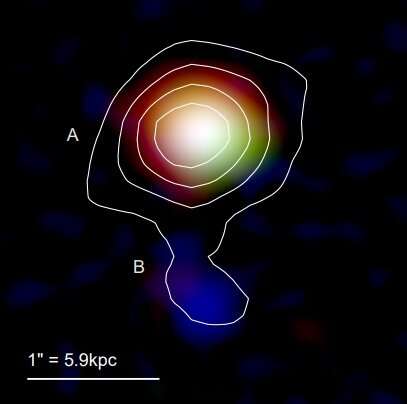A three-color rendition of the dust continuum emission in MAMBO–9: blue represents 870 µm emission, green is 1.3 mm, and red is 3 mm emission with similar beamsizes. Credit: Casey et al., 2019.
Using the Atacama Large Millimeter/submillimeter Array (ALMA), an international team of astronomers has conducted detailed observations of the dusty star-forming galaxy MMJ100026.36+021527.9, better known as MAMBO-9. The study, described in a paper published October 29 on arXiv.org, provides physical characterization of this galaxy, shedding more light on its nature.
Dusty star-forming galaxies (DSFGs) are galaxies experiencing a large burst of high-rate star formation that contain substantial amounts of dust or whose rest-frame optical/ultraviolet light might be significantly obscured. They represent the most intense starbursts in the universe and are crucial to improve our understanding of galaxy formation and evolution.
DSFGs at high redshift (over 4.0) are of special interest. They are the most intense stellar nurseries in the universe, and have star-formation rates (SFRs) of hundreds or thousands solar masses per year. However, the list of known high-redshift DSFGs is still relatively short as finding new objects of this type is extremely difficult.
At a redshift of 5.85, MAMBO-9 is one of such galaxies, identified for the first time in 2007 by the Max-Planck Millimeter BOlometer (MAMBO) instrument at the IRAM 30m radio telescope in Spain. In order to get more information about the properties of this poorly studied galaxy, a group of astronomers led by Catlin M. Casey of the University of Texas at Austin, has performed multiwavelength observations of MAMBO-9 using ALMA.
"Here we present a multiwavelength characterization of the source in order to constrain its physical drivers and characteristics," the astronomers wrote in the paper.
The study confirmed the high redshift of MAMBO-9. This means that this galaxy is the fourth-highest redshift DSFG and highest-redshift unlensed DSFG known to date.
Furthermore, the observations revealed that MAMBO-9 is comprised of at least two galaxies separated by some 19,600 light years from each other. According to the astronomers, these two components, designated MAMBO-9-A and MAMBO-9-B, are likely undergoing a merger or interaction.
"They are likely interacting at this close proximity, and the interaction could play a substantial role in driving gas densities high enough to trigger intense star formation," the authors of the paper noted.
The research found that MAMBO-9-A (northern component) has a relatively high star-formation rate of about 590 solar masses per year, while MAMBO-9-B (southern component) is forming stars at a rate of approximately 220 solar masses per year.
The total halo mass of MAMBO-9 was estimated to be some 3.3 trillion solar masses. Moreover, the galaxy's stellar mass was calculated to be about 3.2 billion solar masses, its dust mass was found to be at a level of 1.3 billion solar masses, and its total molecular hydrogen gas mass is approximately 170 billion solar masses.
The astronomers noted that MAMBO-9's relatively low stellar mass will most likely increase tenfold in the next 40 to 80 million years. This is due to the fact that the galaxy is undergoing a merger-driven starburst converting its large molecular gas reservoir into stars.
More information: Physical Characterization of an Unlensed Dusty Star-Forming Galaxy at z=5.85, arXiv:1910.13331 [astro-ph.GA] arxiv.org/abs/1910.13331
© 2019 Science X Network
























